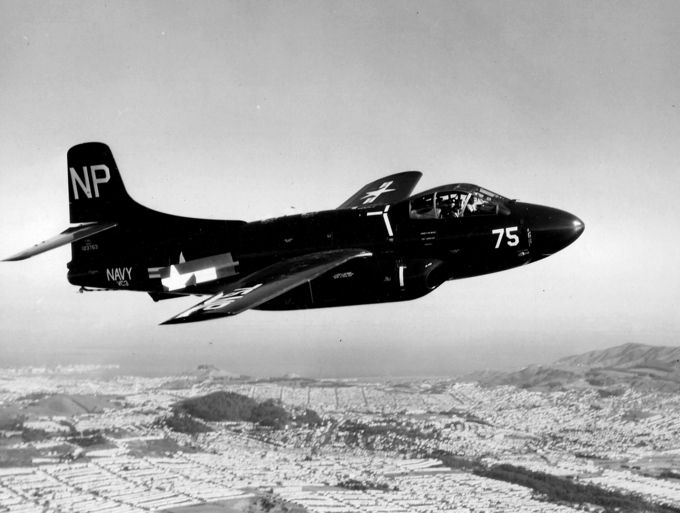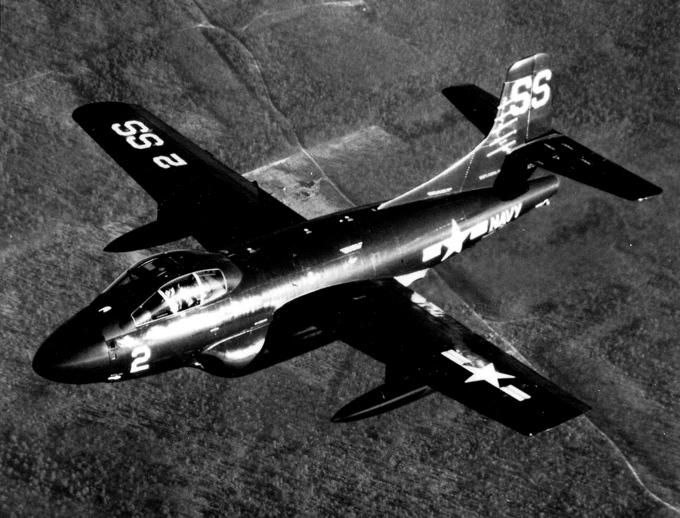Carrier aviation was a relatively new field when World War II began, with some nations starting with biplanes as their main carrier aircraft. However, as technology marched on and aircraft became more sophisticated and robust, the need to mate the new technology to existing roles proved pivotal to keeping the equipment the most advanced. As such, when the US Navy pursued the F3D-1, it aimed to have the first operational jet aircraft that was carrier-capable.
In late 1945, the US Navy was searching for a new carrier-based fighter that was jet-powered and could fly in all weather. The two-seated, twin-engine fighter was to be equipped with a radar and with specifications for a top speed of 500 mph (805 km/h), an operating altitude of 40,000 ft (12,192 m), and able to detect an enemy 125 miles (201 km) away. The Douglas Aircraft Company was among the many companies that were asked to produce an aircraft that met these specifications. Led by designer Ed Heineman, Douglas produced the designs that the US Navy thought suited best and was offered a contract for three prototypes under the designation XF3D-1, with the nickname Skyknight, on 03 April 1946.
The XF3D-1 prototype made its first flight on March 23rd, 1948. Due to the favorable performance, on May 11th, the plane was ordered into production of 28 units as the F3D-1. The first production F3D-1 was delivered in early 1950. By February 1951, the F3D-1 was put into service. However, despite its status, the F3D-1 did not meet all standards for aircraft carrier operations, mainly due to underpowered engines. As such, priority shifted towards the F3D-2 variant and only 28 F3D-1 planes were produced. In all, Douglas would produce 268 F3D Skyknights for U.S. service.
While the F3D-1 stayed stateside to train pilots and radar operators, the F3D-2 was sent to the Korean War in the Spring of 1952. The F3D-2 Skyknights were assigned to Marine Corps night fighter squadrons to escort bombers in nighttime raids. While there, the F3D Skyknights racked up one of the best aerial victory records in Korea for a night fighter, even scoring the first aerial jet-to-jet night victory against a Yak-15 on 03 November 1952. Only one F3D Skyknight was shot down during the duration of the Korean War.
After the Korean War, the F3D Skyknights became used as trainers or testing beds for the then-new air-to-air missiles (AAM), such as the AIM-7 Sparrow missiles. In 1962, the F3Ds were renamed the F-10 Skyknights, with the F3D-1 and F3D-2 being redesignated as F-10A and F-10B, respectively. These would later be used in Vietnam, making the Skyknights the only jet fighter to have flown in the Korean and Vietnam War. The Skyknight's role in Vietnam was reduced, focusing more on electronic warfare with electronic countermeasure (ECM) equipment as the EF-10B in order to counter the new SA-2 Guideline surface-to-air missile. The Skyknights were also used to conduct reconnaissance over Cuba during the 1962 Cuban Missile Crisis.
In 1969, though, all US Navy F-10s were retired and used to test the new avionics systems that were implemented into the F-14 Tomcats. The Marines used their F-10s until May 1970.
Bibliography
- Boeing. "Historical Snapshot: F3D/F-10 SKYKNIGHT FIGHTER." Boeing, Website.
- Baugher, Joseph F. "Douglas F3D-1/F-10A Skyknight" joebaugher.com, 30 Jan. 2000, Website.
- Combat Air Museum. "Douglas F-3D-2T2 (TF-10B) Skyknight" Combat Air Museum, Website.
- Military Factory. "Douglas F3D-1/F-10A Skyknight" Military Factory, 31 May 2016, Website.



